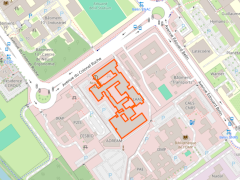Stand-alone networks and applications
The aim is to design methods enabling networks and applications to react autonomously to adverse events and demand fluctuations, with minimal human intervention.
For communication networks, autonomy is a key challenge of high priority, both for the research community and for industrial players and the international working groups that associate them. This term can be found under various nomenclatures such as the ETSI working group "Zero touch network & Service Management (ZSM)" [Sprecher'2018] or the concept of self-driving networks [Jacobs'2018].
In this context, the locks we are considering are related to the joint and consistent consideration of functional (generic for different domains or for a given domain, or mission-specific) and non-functional (confidentiality, security, quality of service, cost in energy consumption or budget) properties (or requirements) of systems. Challenges include managing the dynamic adaptation (in the operational phase) of systems to variations in functional and non-functional requirements, and to changes in the constraints of the deployment infrastructure (as in hybrid environments such as IoT/M2M, Fog Computing, 5G, and satellite). This means, for example, taking into account the confidentiality requirements of private data and processing them locally, while considering the constraints of processing resources (e.g. gateways). Tasks must then be allocated in a way that is compatible with these requirements and constraints. The use of automatic learning and reasoning techniques is both an opportunity we can exploit and a difficulty we must resolve. We also need to manage conflicts between adaptation actions that may arise from contradictory local decisions between the subsystems making up the overall system. We also need to guarantee the coherence of the global sequence (or even the orchestration workflow) of local adaptation actions in a context of distributed resource sharing and composition. The development of approaches for the design, modeling, verification and validation of adaptation management rules (or, more generally, policies and strategies) is a key objective of our prospective work in the field of autonomy for critical IT systems. The main challenges lie in developing cognitive, architectural, behavioral and optimization models that can be verified at different scales and executed in a distributed manner. The absence of initial or global knowledge, or uncertainty about system behavior in the design phase, and the emergence of unexpected behaviors (unwanted, which must be dealt with, in particular) in the operation phase, make current techniques unsuitable or insufficient. Supervised learning, so important for detecting anomalies (security threats or imminent degradation of performance or quality of service in general) becomes unusable in the context of future systems. Techniques such as deep reinforcement learning, distributed learning and explainable learning need to be developed. High-level abstractions for design, management and verification are needed to implement safe solutions usable for future communication networks.
[Sprecher'2018] N. Sprecher, IEEE Softwarization, November 2018 ETSI ZSM Architectural Framework for End-to-End Service and Network Automation. https://sdn. ieee.org/newsletter.
[Jacobs'2018] A. Jacobs et al. Refining Network Intents for Self-Driving Networks. ACM SIGCOMM Computer Communication Review (CCR) 2018.












